A further education in truffles
A few days after visiting the truffle market in Richerenches, we were staying in the medieval town of Uzès in the Gard. While the Gard is technically part of the Languedoc region, it feels very much like Provence.
On one corner of the ancient arcaded Place aux Herbes in the center of town is a small, jewel-like store dedicated to regional delicacies in general, and the truffle in particular. There we got a further education in the black truffle.
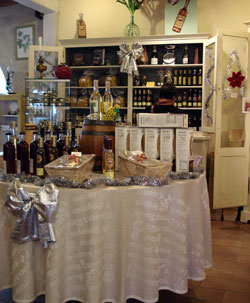 The store itself is a bit overwhelming. Row upon row of truffle-related products line the shelves: truffle oils; truffles preserved in jars; risotto mixes with truffles; cured ham that had been soaked in truffle juice; vacuum packet filet mignon scented with white Italian Alba truffles. And holding a place of honor on the back counter is a footed glass jar, filled with truffles.
The store itself is a bit overwhelming. Row upon row of truffle-related products line the shelves: truffle oils; truffles preserved in jars; risotto mixes with truffles; cured ham that had been soaked in truffle juice; vacuum packet filet mignon scented with white Italian Alba truffles. And holding a place of honor on the back counter is a footed glass jar, filled with truffles.
We waited our turn patiently as Monsieur Balmain, the proprietor, held forth on the finer points of truffles with a prior customer. The gentleman in question, elegantly dressed in black from head to toe, purchased a truffle about the size of a tennis ball. It cost around €250 (about US $325).
When our turn came, Monseiur Balmain started off by taking the cover off the glass jar and inviting us to sniff. The smell was so overwhelming we almost fell over backwards. It was much more intense than the ones at Richerenches which were out in the open air. The truffles were uniformly larger, more swollen. They seemed to seethe with a mysterious energy in the dimly lit store.
In rapid-fire French (which I got maybe half of) Monseiur Balmain gave us a quick education on how to spot a good truffle. He took one of the precious truffles, and sliced off a tiny sliver. Look at the cut surface, he urged us. Notice how it's almost all dark, with barely a trace of white. He then took a smaller truffle from a plastic container, wrapped in a paper towel, and sliced a sliver off of that too. The slice was noticeably different - it was marbled with fine pale lines. This, he said, is a Chinese truffle. It has little scent, and is spongy. He demostrated the sponginess by pressing on the side of the small truffle, then handed it to me. I pressed - it was indeed a bit soft. And now press this he said, handing me the bigger, blacker truffle. It was much firmer. He told us, If you are offered a truffle in a parking lot, be sure to have a small slice cut off like so so you can see. We nodded meekly, our eyes glued to the black lumps of fungus more expensive than gold.
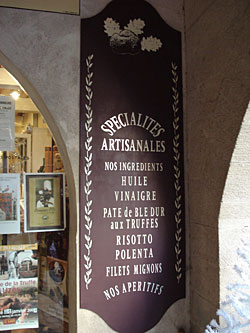 Now came the time to decide - buy a truffle, or not? There really was no question...we couldn't leave without one. We selected one about the size of a newborn baby's fist, and handed it carefully to Monsieur Balmain, who put it on the electronic scale. We held our breath as the price was figured out. Fortunately it was under the amount of cash we had (though about twice the price of the small truffle we had bought in Richerenches. That one was just a bit more marbled than the all-black truffle, with a few white streaks.)
Now came the time to decide - buy a truffle, or not? There really was no question...we couldn't leave without one. We selected one about the size of a newborn baby's fist, and handed it carefully to Monsieur Balmain, who put it on the electronic scale. We held our breath as the price was figured out. Fortunately it was under the amount of cash we had (though about twice the price of the small truffle we had bought in Richerenches. That one was just a bit more marbled than the all-black truffle, with a few white streaks.)
The Uzès truffle is now resting, as per Monsieur Balmains instructions, in a jar in our refrigerator, wrapped in a paper towel, waiting for its star turn.
Maison de la Truffe
27 place aux Herbes
30700 Uzès
Tel. 04 66 63 83 45
Open year round (Note: the main market day in Uzès is Saturday, and it's a treat)
If you enjoyed this article, please consider becoming my patron via Patreon. ^_^

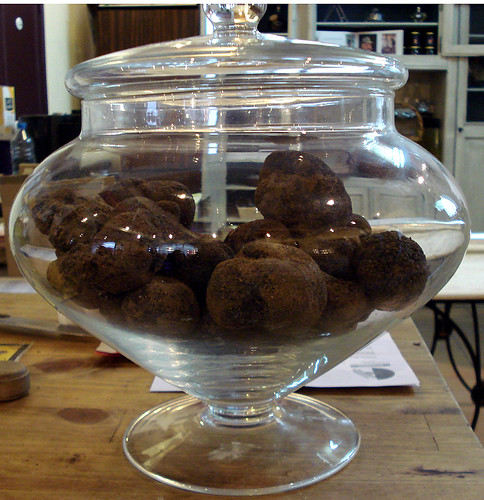
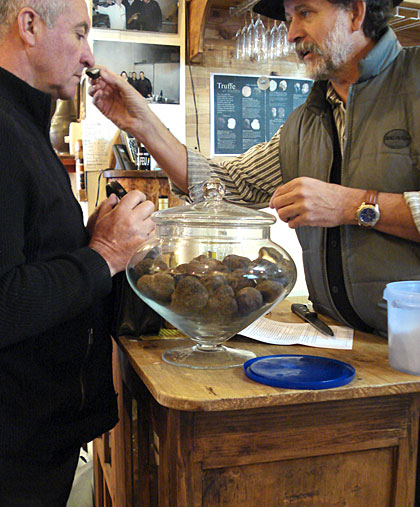
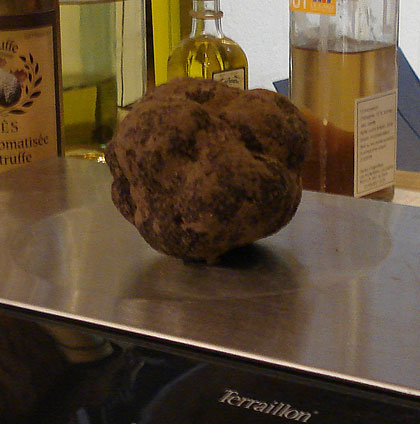
 Welcome to Just Hungry, where we serve authentic Japanese recipes and more! I'm
Welcome to Just Hungry, where we serve authentic Japanese recipes and more! I'm 















Comments
mabel
22 June, 2012 - 01:30
Permalink
Re: A further education in truffles
ooo thanks for the education =)
this post is pretty old so i guess your precious truffle has seen its use in some amazing dish but if u still have a few slivers left, try it in butter! i was served it along with bread someplace ex and it was yummy- should def churn out some of your own butter from the freshest cream n mix tiny flecks of the truffle in with a little salt!